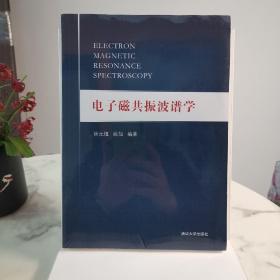
电子磁共振波谱学
¥ 165 九五品
仅1件
作者徐元植、姚加 著
出版社清华大学出版社
出版时间2016-10
版次1
装帧平装
上书时间2023-02-16
- 在售商品 暂无
- 平均发货时间 20小时
- 好评率 暂无
- 最新上架
商品详情
- 品相描述:九五品
图书标准信息
- 作者 徐元植、姚加 著
- 出版社 清华大学出版社
- 出版时间 2016-10
- 版次 1
- ISBN 9787302451655
- 定价 69.00元
- 装帧 平装
- 开本 16开
- 纸张 胶版纸
- 页数 375页
- 字数 549千字
- 正文语种 简体中文
- 【内容简介】
-
本书全面讲解电子磁共振(EMR)的基本原理,包括理论基础、g张量理论、各向同(异)性的超精细结构、精细结构、弛豫与线型线宽、定量测定、顺磁性气体和无机自由基、过渡族元素离子及其配合物等10章。附录中包括EMR的延伸和拓展介绍,以及必要的数学和物理基础知识。
本书可帮助相关领域从业者具备扎实可靠的解谱能力,也可用作相关专业研究生教材。
- 【目录】
-
第1章 绪论 1
1.1 电子磁共振的由来 1
1.2 实验装置 3
1.3 研究对象 9
1.4 展望未来 10
参考文献 11
第2章 理论基础 13
2.1 电子磁共振的唯像描述 13
2.2 角动量和磁矩 14
2.3 磁场的单位 21
2.4 外磁场与磁矩的相互作用 22
2.5 在外磁场中磁矩与电磁辐射场的相互作用 24
2.6 核磁矩与电子磁矩在外磁场中的相互作用 26
习题 27
参考文献 27
深入的参考读物 27
第3章 g张量理论 29
3.1 Landé因子 29
3.2 g张量的矩阵表象 31
3.3 无规取向体系中的g张量 38
习题 42
参考文献 42
深入的参考读物 43
第4章 各向同性的超精细结构 44
4.1 超精细互作用的理论探讨 44
4.2 各向同性超精细互作用的能量算符 45
4.3 波谱的各向同性超精细结构 50
4.4 有机π-自由基波谱的超精细结构 62
4.5 共轭体系波谱产生超精细分裂的机理 74
4.6 其他(非质子)核的超精细分裂 82
习题 85
参考文献 86
深入的参考读物 87
第5章 各向异性的超精细结构 88
5.1 各向异性的超精细互作用 89
5.2 各向异性超精细互作用的矩阵解析 90
5.3 实例演示 95
5.4 各向异性的超精细耦合张量与自由基的结构 101
5.5 g张量和A张量组合的各向异性性 109
5.6 无规取向体系中A张量的各向异性性 109
习题 111
参考文献 111
深入的参考读物 112
第6章 精细结构 113
6.1 零场分裂 114
6.2 两个电子互作用的自旋Hamiltonian 115
6.3 三重态分子(S?=?1)体系 126
6.4 无规取向的三重态体系 133
6.5 双基 136
习题 139
参考文献 139
深入的参考读物 140
第7章 弛豫与线型线宽 141
7.1 自旋弛豫的模型 141
7.2 线型、线宽和谱线强度 150
7.3 线型的动态效应 155
7.4 饱和-转移的波谱 173
7.5 波谱信号振幅随时间的变化 174
习题 175
参考文献 176
深入的参考读物 178
第8章 定量测定 179
8.1 影响波谱定量测定的主要因素 180
8.2 标准样品的选择与制备 190
8.3 关键性参数及其对EMR信号强度的影响 193
8.4 定量测定可能达到的准确度 194
习题 195
参考文献 195
第9章 顺磁性气体和无机自由基 198
9.1 顺磁性气体的波谱 198
9.2 为研究顺磁性气体波谱的技术拓展 210
9.3 无机自由基 211
9.4 固体中的点缺陷 214
9.5 导体和半导体的波谱 217
9.6 从EMR数据中估计结构的方法 219
习题 220
参考文献 220
深入的参考读物 223
第10章 过渡族元素离子及其配合物 224
10.1 过渡族元素离子的电子基态 224
10.2 轨道简并度在配位场中的解除 226
10.3 配位场的电势 230
10.4 在配位场中过渡金属离子的能级分裂 231
10.5 旋-轨耦合与自旋Hamiltonian 238
10.6 具有轨道非简并的基态离子 241
10.7 具有轨道简并的基态离子 254
10.8 稀土离子的波谱 263
10.9 过渡金属配合物的波谱 266
习题 266
参考文献 267
深入的参考读物 270
实验 271
附录1 EMR的延伸和拓展 287
附录2 数学准备 338
附录3 量子力学中的角动量理论与定态微扰理论 353
附录4 常用的物理学基本常数与换算因子 369
附录5 常见磁性核的自然丰度、核自旋、核旋磁比和超精细耦合常数 372
CONTENTS
CHAPTER 1 INTRODUCTION 1
1.1 Origin of EMR 1
1.2 Experimental Apparatus 3
1.3 Target of Research 9
1.4 Prospects for Future 10
References 11
CHAPTER 2 Theoretical Basics 13
2.1 Phenomenal Description of EMR 13
2.2 Angular Momentum & Magnetic Moment 14
2.3 Unit of Magnetic Field 21
2.4 Interaction between Outer Magnetic Field with Moment 22
2.5 Interaction between Moment with Electromagnetic Field under Outer
Magnetic Field 24
2.6 Interaction between Nuclear Magnetic Moment with Electron Magnetic
Moment under Outer Magnetic Field 26
Exercises 27
References 27
Further Readings 27
CHAPTER 3 g-Tensor Theory 29
3.1 Landé Factor 29
3.2 Matrix Presentation of g-Tensor 31
3.3 g-Tensor of Irregular Orientation System 38
Exercises 42
References 42
Further Readings 43
CHAPTER 4 Isotropic Hyperfine Structure 44
4.1 Theoretical Discussion of Hyperfine Interaction 44
4.2 Energy Operator of Isotropic Hyperfine Interaction 45
4.3 Spectral Isotropic Hyperfine Structure 50
4.4 Hyperfine Structure of Organic π-Free Radical Spectrum 62
4.5 Mechanism of Hyperfine Splitting of Conjugate System Spectrum 74
4.6 Hyperfine Splitting of Others (non-proton) 82
Exercises 85
References 86
Further Readings 87
CHAPTER 5 Anisotropic Hyperfine Structure 88
5.1 Anisotropic Hyperfine Interaction 89
5.2 Matrix Interpretation of Anisotropic Hyperfine Interaction 90
5.3 Living Example Demonstration 95
5.4 Anisotropic Hyperfine Coupling Tensor with Free Radical Structure 101
5.5 Anisotropy of g- & A-Tensor Combinations 109
5.6 Anisotropy of A-Tensor for Irregular Orientation System 109
Exercises 111
References 111
Further Readings 112
CHAPTER 6 Fine Structure 113
6.1 Zero Field Splitting 114
6.2 Spin Hamiltonian of Two Electron Interaction 115
6.3 Spectra of Triplet (S?=?1) State Molecular System 126
6.4 Spectra of Triplet State in Irregular Orientation System 133
6.5 Biradicals 136
Exercises 139
References 139
Further Readings 140
CHAPTER 7 Relaxation and Line Shape & Line Width 141
7.1 Model of Spin Relaxation 141
7.2 Shape, Width and Intensity of Spectral Line 150
7.3 Dynamic Effects of Lineshape 155
7.4 Saturation-Transfer of Spectra 173
7.5 Intensity of Signal Dependent on Time 174
Exercises 175
References 176
Further Readings 178
CHAPTER 8 Quantitative Determination 179
8.1 Main Factors of Influence for Quantitative Determination 180
8.2 Selection & Preparation of Standard Samples 190
8.3 Crucial Parameters and Its Effect on the Intensity of EMR Signal 193
8.4 Achievable Accuracy of Quantitative Determination 194
Exercises 195
References 195
CHAPTER 9 Paramagnetic Gases & Inorganic Radicals 198
9.1 Spectra of Paramagnetic Gases 198
9.2 Expend of Research for EMR of Paramagnetic Gases 210
9.3 Inorganic Radicals 211
9.4 Point Defects in Solid States 214
9.5 Spectra of Conductor & Semiconductor 217
9.6 Method of the Structure Estimated by the Data of EMR 219
Exercises 220
References 220
Further Readings 223
CHAPTER 10 Transition Metal Ion & Its Complexes 224
10.1 Electron Ground State of Transition Metal Ion 224
10.2 Orbital Degeneracy Rescinded by Ligand Field 226
10.3 Electric Potential of Ligand Field 230
10.4 Energy Level Splitting of Transition Metal Ion in Ligand Field 231
10.5 Spin-Orbital Coupling & Spin Hamiltonian 238
10.6 Ground State Ion with Orbital Non-degeneracy 241
10.7 Ground State Ion with Orbital Degeneracy 254
10.8 EMR Spectra of Rare Earth Ions 263
10.9 EMR Spectra of Transition Metal Complexes 266
Exercises 266
References 267
Further Readings 270
Experiments 271
Appendix 1 Stretch & Expend of EMR 287
Appendix 2 Mathematical Preparations 338
Appendix 3 Angular Momentum & Stable State Perturbation Theory in
Quantum Mechanics 353
Appendix 4 Basic Constants & Conversion Factors in Common Use 369
Appendix 5 The Natural Abundance, Nuclear Spin, Nuclear Magnetiogyric Ratio
of Common Magnetic Nuclei and Their Hyperfine Coupling
Parameters 372
— 没有更多了 —














以下为对购买帮助不大的评价